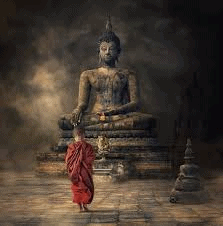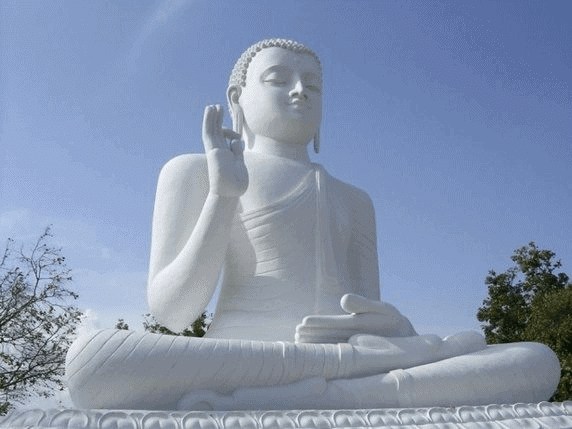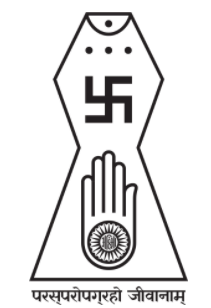Overview: Buddhism and Jainism | General Test Preparation for CUET UG - CUET Commerce PDF Download
| Table of contents |

|
| Causes of New Movement |

|
| Buddhism |

|
| The Damma or |

|
| Doctrine of Buddhism |

|
| Jainism |

|
| Difference between Jainism and Buddhism and Vedic Religion |

|
Causes of New Movement
- The Kshatriya reaction against the domination of the priestly class called Brahmanas. Mahavira and Gautama Buddha, both belonged to the Kshatriya clan.
- Indiscriminate killing of cattle for Vedic sacrifices and food had led to the destabilization of the new agricultural economy which was dependent on cattle for ploughing the fields. Both Buddhism and Jainism stood against this killing.
- The growth of cities with the increase in the circulation of Punch Marked coins and trade and commerce had added to the importance of Vaishyas who looked for a new religion to improve their position. Jainism and Buddhism facilitated their needs.
- The new forms of property created social inequalities and the common people wanted to get back to their primitive form of life.
- Growing complexity and degeneration of Vedic religion.
Buddhism
Buddhism stands for 3 pillars:
(a) Buddha: Its Founder
(b) Dhamma: His Teachings
(c) Sangha: order of Buddhist monks and nuns
Gautam Buddha
- Also known as Sakyamuni or Tathagata.
- Born in 536 BC. On the Vaisakha Poornima day at Lumbini (near Kapilavastu) in Nepal.
- His father Suddhodhana was the Saka ruler
- His mother (Mahamaya, of the Kosala dynasty) died after 7 days of his birth. Brought up by the stepmother Gautami.
- Married at 16 to Yashodhara. Enjoyed the marital life for 13 years and had a son named Rahula.

- Four Sights of Buddha's life at the age of 29 had moved him to the path of renunciation:
(a) An old man
(b) A diseased person
(c) An ascetic
(d) A dead person - He left his place at 29 in search of truth (also called ‘Mahabhinishkramana’ or the Great Renunciation) and wandered for 6 years.
- He attained ‘Enlightenment’ at 35 at Gaya in Magadha (Bihar) under the Pipal tree.
- He delivered the first sermon at Sarnath where his five disciples had settled. His first sermon is called ‘Dharmachakrapravartan’ or ‘Turning of the wheel of law’.
- Attained Mahaparinirvanda at Kushinagar (identical with village Kasia in Deoria district of UP) in 483 BC at the age of 80 in the Malla Republic.
Important events in the life of Buddha:
The Damma or
The Damma or
Doctrine of Buddhism
Doctrine of Buddhism
1. The Four Great Truths or Four Noble Truths
- Dukha: The world is full of sorrow and misery.
- Samyuda: The of causes all the pain and misery is desire.
- Nirodha: The pain and misery can be ended by killing or controlling desire.
- Nirodha Gamini Pratipada: Path leading towards cessation of sorrow i.e. desire can be controlled by following Eight fold Paths.
2. The Eight Fold Path or Ashtangika Marga
- Right observation
- Right determination
- Right exercise
- Right action
- Right speech
- Right memory
- Right meditation
- Right livelihood
3. Madhya Marga: To avoid the excess of both luxury and austerity.
4. Belief in Nirvana:
- When desire ceases, rebirth ceases and nirvana is attained le. freedom from the cycle of birth, death and rebirth is gained by following the 8-fold path.
- According to Buddha, soul is a myth.
5. Belief in Ahimsa: One Should Not Cause Injury To Any Living Being, Animal Or Man
6. Law of Karma: Man reaps the fruits of his past deeds.
The Sangha
- Consists of monks (Bhikshus or Shramanas) and nuns.
- Bhikshus acted as a torchbearer of the dhamma
- Apart from Sangha, the worshippers were called Upasakas.
Special Features of Buddhism And The Causes of Its Spread
- Buddhism does not recognize the existence of god and soul.
- Women were also admitted to the Sangha. Sangha was open to all, irrespective of caste and sex.
- Pali language was used which helped in the spread of Buddhist doctrines among the common people.
- Ashoka embraced Buddhism and spread it to Central Asia, West Asia and Srilanka.
- Buddhist Councils:
(a) First Council: The first council was held in the year 483 B.C at Saptaparni caves near Rajgriha in Bihar under the patron of king Ajatshatru, during the first council two Buddhist works of literature were compiled Vinaya and Sutta Pitaka by Upali.
(b) Second Council: The second council was held in the year 383 B.C at Vaishali under the patron of king Kalashoka.
(c) Third Council: The third council was held in the year 250 B.C at Patliputra under the patron of King Ashoka the Great, during the third council Abhidhamma Pitaka was added and the Buddhist holy book Tripitaka was compiled.
(d) Fourth Council: The fourth council was held in the year 78 A.D at Kundalvan in Kashmir under the patron of king Kanishka, during this council Hinayana and Mahayana were divided.
 View Answer
View Answer 
Note:
In Mahayana, idol worship is there. It became popular in China, Japan, Korea, Afghanistan, Turkey and other SE countries. Hinayana became popular in Magadha and Sri Lanka. It believed in individual salvation and not in idol worship. Apart from these 2, there is a third vehicle, called "Vajrayana', which appeared in 8th century and grew rapidly in Bihar and Bengal. They did not treat meat, fish, wine, etc, as a taboo in dietary habit and freely consumed them.
Importance and Influence of Buddhism
1. Literature
- Buddhist scriptures in pali is commonly referred to as Tripitaka i.e. threefold basket.
(a) Sutta Pitaka: Buddha's sayings
(b) Vinaya Pitaka: Monastic code
(c) Abhidhamma Pitaka: Religious discourses of Buddha - Milindapanho: The dialogue between Menander and Saint Nagasena
- Dipavamsha and Mahavamsha: The great chronicles of Sri Lanka
- Buddhacharita by Ashvagosha
2. Sects
- Hinayana (Lesser Wheel): They believe in the real teachings of Gautam Buddha of attaining Nirvana. They do not believe in idol worship and the Pali language was used in the Hinayana text.
- Mahayana (Greater Wheel): They believe that Nirvana is attained by the grace of Gautam Buddha and following Boddhisattvas and not by following his teachings. They believe in idol worship and Sanskrit was used in the Mahayana text.
- Vajrayana: They believe that Nirvana is attained with the help of magical tricks or black magic.
3. Bodhisattvas
- Vajrapani
- Avalokitesvara or Padmapani
- Manjushri
- Maitreya
- Kshitigriha
- Amitabha/Amitayusha
4. Buddhist Architectures
- Places of Worship: Stupas containing the relics of Buddha or Bodhisattvas. Chaityas are the prayer hall while Viharas are the place of residence of monks.
- Development of Cave architecture eg. Barabar caves in Gaya
- Development of Idol worship and sculptures
- Growth of universities of par excellence which attracted students from all over the world.
Causes of the Decline of Buddhism
- Buddhism succumbed to the rituals and ceremonies which it had originally denounced.
- They gave up Pali and took Sanskrit. They began to practice idol worship and received numerous offerings from devotees.
- Monasteries came under the domination of ease-loving people and became the center of corrupt practices.
- Vajrayana form started to develop.
- Buddhists came to look upon women as objects of lust.
Jainism
- Founded by Rishabhanath.
- There were 24 Tirthankaras (Prophets or Gurus), all Kshatriyas.
- First was Rishabnath (Emblem: Bull). His reference is also in Rigveda.
- There is no historical basis for the first 22 Tirthankaras. Only the last 2 Tirthankaras made a historical presence.
- The 23rd Tirthankar Parshwanath (Emblem: Snake ) was the son of king Ashvasena of Banaras.
His main teachings: Non-lying, Non-injury, Non-stealing, Non-possession - The 24th and the last Tirthankar was Vardaman Mahavira (Emblem: Lion).

Vardaman Mahavira
- Mahavira was related to Bimbisara.
- He was born in Kundagram (District Muzaffarpur, Bihar) in 599 BC.
- His father Siddhartha was the head of the Jnatrika clan and mother was Trishala, sister of Lichchavi Prince Chetak of Vaishali.
- He was married to Yashoda, had a daughter named Priyadarsena, whose husband Jamali became his first disciple.
- At 30, after the death of his parents, he became an ascetic.
- In the 13th year of his asceticism (on the 10th of Vaishakha), outside the town of Jrimbhikgrama, attained the supreme knowledge (Kaivalya).
- From now on he was called Jaina or Jitendriya and Mahavira, and his followers were named Jains. He also got the title of Arihant, i.e worthy.
- At the age of 72, attained death at Pava, near Patna, in 527 BC.
- Mahavira preached almost the same message as Parsvanath and added one more, Brahmcharya (celibacy) to it.
- After the death of Mahavira, during the reign of King Chandragupta Maurya, a severe famine led to a great exodus of Jain monks from the Ganga valley to the Deccan, where they established important centers of their faith.
- This migration led to a great schism in Jainism:
(a) Bhadrabhau, who led the emigrants, insisted on the retention of the rule of nudity that Mahavira had established.
(b) Sthulabhadra, the leader of the monks who remained in the north, allowed his followers to wear white garments, owing to the hardships and confusions of the famine. - Hence arose the two sects of the Jains, the Digambaras (sky-clad, i.e., naked) and the Svetambaras (white-clad).
Teachings of Mahavira
- Rejected the authority of the Vedas and do not attach any importance to the performance of sacrifices.
- He believed that every object, even the smallest particle, possesses a soul and is endowed with consciousness. That is why they observe strict non-violence.
- The Jains reject the concept of a Universal Soul of a Supreme Power as the creator or Sustainer of the universe.
- Jainism does not deny the existence of gods but refuses to give gods any important part in the universal scheme. Gods are placed lower than the Jina.
- Universal brotherhood (non-belief in caste system).Question for Overview: Buddhism and JainismTry yourself:Mahavira's first disciple wasView Solution
Doctrine of Jainism
Five Vows of Jainism
- Ahimsa: Non-violence
- Satya: Do not speak a lie
- Asteya: Do not steal
- Aparigraha: Do not acquire property
- Brahmacharya: Celibacy

Three Main Principles
- Ahimsa
- Anekantavada
- Aparigraha
Triratna's of Jainism
- Right Faith: Samayak Shradha
- Right Knowledge: Samayak Jnan
- Right Conduct: Samayak karma
Five types of knowledge
- Mati jnana
- Shruta jnana
- Avadhi jnana
- Manahparayaya Jnana
- Keval Jnana
Jain council
- 1st Council at Patliputra under the Patron of Chandragupta Maurya in 300 BC during which the 12 angas were compiled.
- 2nd Council at Vallabhi in 512 AD during which the final compilation of 12 angas and 12 upangas was done.Question for Overview: Buddhism and JainismTry yourself:1st Council at Patliputra under the Patron of Chandragupta Maurya in 300 BC during which the _____ angas were compiled.View Solution
Importance and Influence of Jainism
Sects
Shwetambars:
- Sthulabhadra, People who put on white robes.
- Those who stayed back in the North during the times of famine
Digambars:
- Bhadrabahu, People who have naked attire
- The exodus of monks to Deccan and South during the times of Magadhan famine.
Jain Literature
- Jain literature is in Ardh-Magadhi and Prakrit dialects.
- Prakrit was the common language of people than using Sanskrit. In this way, Jainism reached far and wide through people.
- The important literary works are:
(a) 12 Angas
(b) 12 Upangas
(c) 10 Parikramas
(d) 6 Chhedsutras
(e) 4 Mulasutras
(f) 2 Sutra Grantas - Part of Sangam literature is also attributed to Jain scholars.
- Due to the influence of Jainism, many regional languages emerged out, like Sauraseni, out of which grew the Marasthi, Gujarat, Rajasthani, and Kannada.
Causes responsible for the decline of Jainism in India
1. Lack of royal patronage
- The initial tempo of royal patronage of Jainism by Bimbisara, Ajatasatru, Udayin, and Kharavela was not kept up by kings and princes of later times.
- The zeal and determination of Asoka, Kanishka, and Harsha to spread Buddhism came to eclipse Jainism.
- Thus, a lack of sincere and determined royal patronage came to relegate Jainism.
2. Lack of efforts
- There was also a decline in the missionary zeal and sincerity of the Jaina mendicants.
- They were no more particular in undertaking the strain of spreading Jainism in villages and towns.
- The traders and businessmen still remained loyal to Jainism. But they had no time to do anything for the spread of Jainism.
3. Severity of Jainism
- The severity of Jainism boomeranged against it to bring about its decline.
- Unlike the ‘middle path’ of Buddhism, Jainism stood for severe penance, meditation, fasting, and restraint, etc.
- All these were too severe to endure. People soon became disillusioned with it. In course of time, Jainism, once adored, became alienated from the people.
4. Unintelligible Philosophy
- Most of the Jaina philosophy was unintelligible for the masses.
- The concepts of Jeeva, Ajeeva, Pudgala, Syadbada etc. could not be understood properly by the people. Many could not accept the view that stone, water, tree or earth had a soul of their own.
- There was, thus, a gradual decline in popular faith for Jainism. This paved the way for its decline.
5. Factionalism in Jainism
- Factionalism among the Jainas after the death of Mahavira was the fifth cause of the decline of Jainism. Some now advocated to literally follow the teachings of Mahavira, while others wanted to tone down the severity of Jainism.
- As such, the rift led to a division in Jain ranks. They were now divided into ‘Digamvara’ and ‘Swetamvara’ groups.
(a) The ‘Digamvara’ group, led by Bhadrabahu, gave up dress, adopted severe penance for self-purification, and became indifferent to worldly life.
(b) The ‘Swetamvara’ group, led by Sitalabahu, wore a white dress. The division weakened Jainism and as such, its spread came to be curtailed.
6. Spread of Buddhism
- Buddhism came as a formidable obstacle in the path of the spread of Jainism.
- Buddhist was simple and intelligible. There was no severity in it. Even a householder could follow it.
- Thus, Jainism which gained momentum came to a declining stage after the spread of Buddhism.
7. Role of Hindu preachers
- Hinduism posed threats to Jainism and put constant problem on the path of the spread of Jainism
- Nimbarka, Ramanuja, Sankaracharya, etc. came to make the foundation of Hinduism more solid and stronger.
- The rise of Vaisnavism, Saivism, and Saktism paled Jainism into comparative insignificance.
The decline of Jainism, thus, became inevitable and unavoidable.
Difference between Jainism and Buddhism and Vedic Religion
- They did not attach any importance to the existing Varna system.
- They preached the Gospel of non-violence.
- They accepted Vaishyas, including the Moneylenders who were condemned by Brahmanas.
- They preferred simple, puritan and ascetic living.
|
164 videos|630 docs|1146 tests
|
FAQs on Overview: Buddhism and Jainism - General Test Preparation for CUET UG - CUET Commerce
| 1. What are the main causes that led to the emergence of new movements in Buddhism and Jainism? |  |
| 2. How does the Damma (Doctrine) of Buddhism shape the new movement? |  |
| 3. What are the main differences between Jainism and Buddhism in comparison with the Vedic religion? |  |
| 4. How does Buddhism and Jainism address the spiritual needs of the masses differently from the Vedic religion? |  |
| 5. How did the presence of charismatic leaders like Gautama Buddha and Mahavira contribute to the growth of Buddhism and Jainism? |  |
















